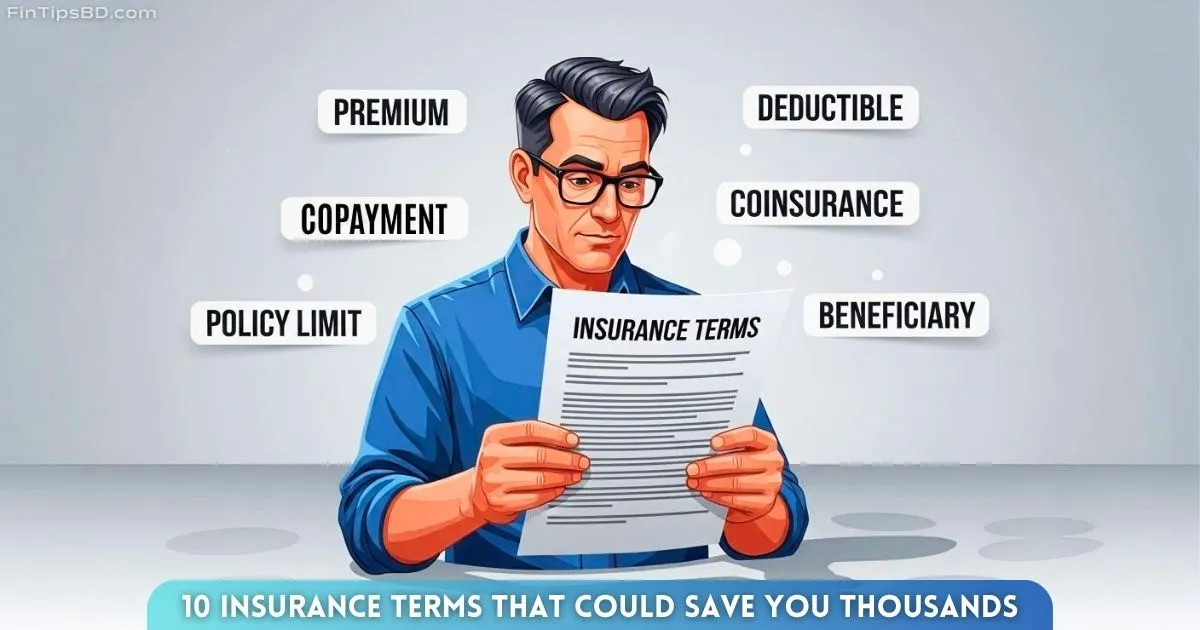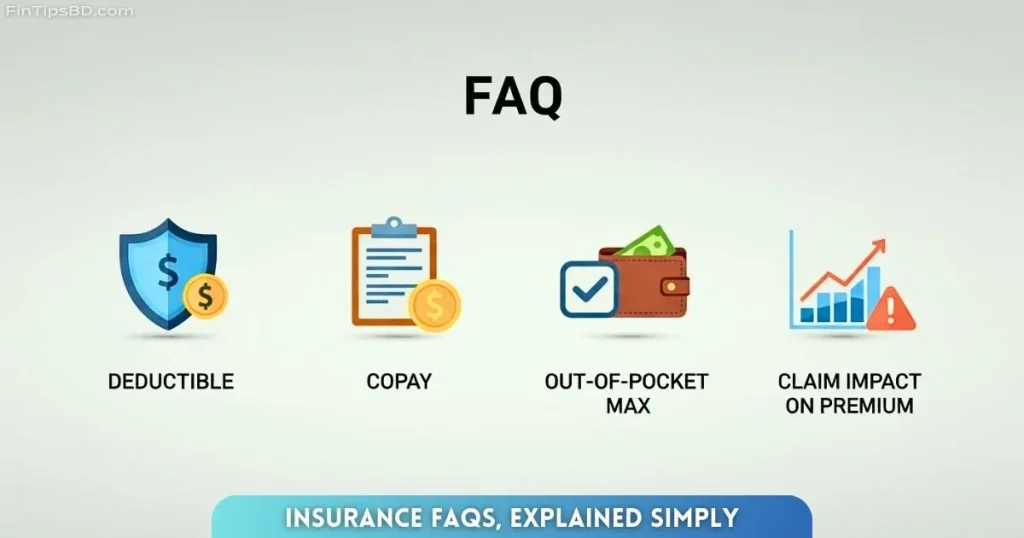10 Must-Know Insurance Terms That Could Save You Thousands – Don’t Get Tricked Again

Ever feel confused while going through your insurance policy? You’re not the only one. The way insurance is written can feel like it’s in another language—and misunderstanding just one detail can cost you a lot. That’s why we put together this beginner insurance guide. It breaks down common insurance jargon so you can actually understand what you’re signing up for. Knowing these insurance definitions isn’t about showing off—it’s about protecting your finances, your house, your health, and your future.
Table Of Contents
Why Knowing Insurance Terms Really Matters
Insurance companies write policies using technical insurance terms that can trip people up. If you don’t fully get what you’re reading, here’s what can happen:
- You might get a claim denied even though you thought it was covered.
- You could end up paying for expenses out of your own pocket.
- You might be paying for coverage you don’t even need.
A big part of the problem comes down to not knowing just a handful of key types of insurance terms. But once you’ve got a grip on these insurance basics for beginners, learning how to read an insurance policy becomes way easier and less stressful.
Key Insurance Terms Made Simple
Let’s walk through ten of the most important insurance terms that can actually help you save money and avoid major headaches.
1. Premium
Your premium is what you pay on a regular basis—monthly, quarterly, or yearly—to keep your policy active.
Why it matters: A lower premium might seem like a win, but it usually means you’ll be stuck with higher out-of-pocket costs later, like a bigger deductible or limited coverage. On the flip side, a higher premium usually means more complete protection. When comparing insurance, don’t just look at the monthly bill. A lower premium can end up costing more when you actually file a claim. Always weigh the premium against what’s really being covered and how much you’d need to pay if something goes wrong.
2. Deductible
A deductible is how much you need to pay yourself before your insurance starts covering anything.
Example: Say your car insurance has a $1,000 deductible and you get into an accident that causes $2,500 in damage. You’d pay the first $1,000, and your insurer would pay the remaining $1,500.
Why it matters: A higher deductible usually brings your premium down. But it also means you’ll need to have more cash ready if something happens. Keep in mind: some policies have separate deductibles depending on the kind of damage—like theft, wind, or water damage. Always read the fine print so you know exactly what you’re signing up for.
3. Copayment (Copay)
A copay is a flat fee you pay for specific services like doctor visits or prescriptions, even if you have health insurance.
Why it matters: These charges can add up fast—especially if you’re seeing specialists or managing chronic conditions. Always check ahead to see what services come with a copay and how much it’ll be. It’s one of the small costs that sneak into your overall healthcare expenses, making it an important health insurance term to understand.
4. Coinsurance
Coinsurance is the percentage you split with your insurance company after your deductible has been paid.
Example: If your coinsurance is 20%, and you have a $1,000 hospital bill after hitting your deductible, you’ll pay $200 and your insurer pays the rest.
Why it matters: A lot of people think that once the deductible’s done, they’re off the hook—but coinsurance still applies. And during big medical events or hospital stays, this can add up fast. Knowing how coinsurance works is key to understanding insurance for your healthcare needs.
5. Out-of-Pocket Maximum
This is the highest total amount you’ll pay in a year for covered services. Once you hit that number, your insurer pays 100% of anything else that’s covered. It’s a critical health insurance term to know.
Why it matters: This limit is your financial safety cap. Once you reach it, you’re shielded from more costs (unless it’s for services outside your network or not covered). This total includes deductibles, copays, and coinsurance—but not premiums. Knowing this helps you plan for worst-case scenarios.
6. Policy Limit
A policy limit is the highest amount your insurance company will pay for a covered loss under a specific section of your policy.
Why it matters: If the total cost goes beyond your policy’s limit, you’ll be responsible for paying the difference.
Example: Let’s say your home insurance has a liability limit of $100,000, but you’re sued for $150,000 after someone gets injured on your property. Your insurer will only cover up to $100,000, and you’ll need to cover the other $50,000 yourself. If you have a lot of assets, consider increasing your limits or adding umbrella coverage—it’s a smart move when it comes to understanding insurance and protecting what you’ve worked for.
7. Exclusion
An exclusion is something your policy specifically says it doesn’t cover. These are usually listed in detail and are crucial to grasp when you’re figuring out how to read an insurance policy.
Common exclusions include: Flood damage, earthquakes, mold, intentional harm, and pre-existing conditions (in many health insurance terms).
Why it matters: Just because you have insurance doesn’t mean you’re covered for everything. If something isn’t clearly included, it’s probably excluded. That’s why reading the exclusions section is so important. Don’t be shy—ask your agent if anything feels unclear. Knowing this is key to mastering insurance basics for beginners and avoiding unwanted surprises.
8. Rider (or Endorsement)
A rider, sometimes called an endorsement, is an add-on to your standard policy that gives you extra coverage.
Example: If your homeowner’s policy doesn’t fully cover valuable jewelry, you can buy a jewelry rider to insure your engagement ring.
Why it matters: Most standard insurance plans have limits on what they’ll pay for high-value items. A rider lets you boost protection for specific belongings or situations. Got expensive electronics, musical gear, or collectibles? This is where a rider comes in handy. It’s a flexible way to tailor your coverage and deepen your understanding of insurance in a more practical, real-life way.
9. Beneficiary
A beneficiary is the person—or group—you name to receive the money from your life insurance policy when you die.
Why it matters: The whole point of life insurance is to support the people you care about. But if you forget to update your beneficiary, the payout might go to someone you didn’t intend—like an ex-spouse instead of your kids. After big life events like getting married, divorced, or having a child, double-check and update your beneficiary info. It’s a small step that makes a huge difference and ensures your wishes are followed.
10. Grace Period
The grace period is the window of time after a missed payment where you can still make your premium payment and keep your coverage.
Typical length: Usually 15 to 30 days, depending on your policy and provider.
Why it matters: Life gets hectic, and a grace period gives you a cushion so your policy doesn’t cancel right away if you’re late on a payment. But don’t push your luck—miss the deadline, and your coverage could lapse. That could mean reapplying, paying more, or getting denied altogether. Try to pay on time, but know your grace period just in case life throws a curveball.
FAQs: Breaking Down Insurance Terms Even More

What’s the difference between a deductible and a copay?
A deductible is the amount you pay first before your insurance starts helping with costs. A copay is a smaller set fee you pay for certain services, even after the deductible’s been met—especially in health insurance terms.
Does coinsurance still apply after I’ve hit my out-of-pocket maximum?
Nope. Once you’ve hit your out-of-pocket limit, your insurance will pick up 100% of the approved expenses for the rest of that coverage year. That’s the financial safety net built into your plan.
Can my premium go up if I file a claim?
Yes, especially with car or home insurance. If you file multiple claims, your insurer might see you as a higher risk. That can lead to higher premiums when you renew. How much it goes up depends on how often you’ve filed and what kind of claims they were.
What if I don’t understand part of my policy?
Ask. Seriously—ask. You’re not supposed to be an expert in the full insurance glossary. Your insurer’s job is to explain it. If something sounds vague or too technical, speak up. Get it in plain English before you sign anything.
Final Thoughts: Empower Yourself with Insurance Knowledge
Insurance terms are more than technical phrases—they shape what your policy includes, what’s left out, and how much you’ll end up paying. Without a solid understanding insurance, you’re operating at a disadvantage. But now that you’re familiar with these essential insurance definitions and have a clearer grasp of what policies really mean, you’re in a much stronger position to pick coverage that fits your needs—not just your budget.
Save this complete beginner insurance guide. Use it when you’re comparing policies or renewing coverage. And if someone you know is new to insurance, share it with them too. A little knowledge can go a long way—this guide might be the reason someone avoids a big financial mistake.
By building a strong foundation in insurance basics for beginners, you’ll not only feel more confident—you’ll also be able to make smarter decisions that protect your home, your health, your money, and your future.
